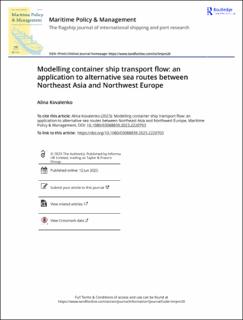Modelling container ship transport flow : an application to alternative sea routes between Northeast Asia and Northwest Europe
Peer reviewed, Journal article
Published version
Permanent lenke
https://hdl.handle.net/11250/3082343Utgivelsesdato
2023Metadata
Vis full innførselSamlinger
Originalversjon
Kovalenko, A. (2023). Modelling container ship transport flow : an application to alternative sea routes between Northeast Asia and Northwest Europe. Maritime Policy & Management. doi: 10.1080/03088839.2023.2220703Sammendrag
The Northeast Passage (NEP) has always been an attractive transport alternative for trade between Northwest Europe and Northeast Asia due to its shorter distance. While a growing body of literature addresses the economic and technical viability of NEP transit shipping, there is still a need for increased knowledge on the features of maritime trade between the regions that could potentially use the route. This study aimed to propose a conceptual model to explain the main factors influencing the cargo demand transported by container ships in order to analyse the types of trade that could increase by using the NEP. Structural equation modelling (SEM) was applied to the empirical data on trade volumes between Northwest Europe and Northeast Asia and suggested that logistics performance has the greatest impact on total volume of container ship flow between these regions. The data of maritime trade volume are further disaggregated to examine how the impact of the analysed factors varied between commodity groups. This study contributes to identifying which type of cargo flow may be the most receptive in case of opening the NEP for regular shipping whilst offering insights into the impact of global economic policy uncertainty on container ship demand.

